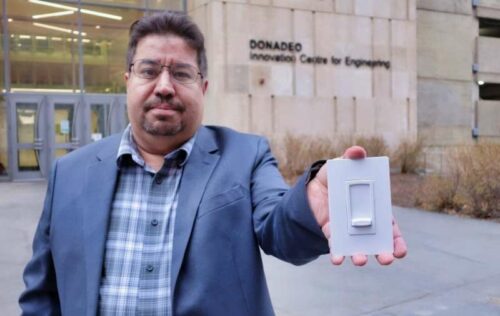Explore the potential to reduce construction costs, lower energy bills, and minimize carbon emissions in this game-changing advancement in smart home technology.

Wireless switches have existed for some time, featuring a transmitter on the switch and a receiver near the target appliance. While they have demonstrated their ability to cut material and labor expenses associated with house wiring, their reliance on batteries has been a persistent challenge. This has proved inconvenient for homeowners, especially when dealing with numerous switches in a single residence.
In a groundbreaking development, a researcher at the University of Alberta’s engineering department introduced a wireless light switch that could slash house wiring costs by up to 50%. Driven by the pursuit of more efficient and eco-friendly solutions, this wireless switch innovation by Kambiz Moez, the director of electrical engineering, marks a significant leap forward in smart home technology. What sets Moez’s system apart is its capacity to function without batteries, drawing energy from ambient sources, such as radio frequency (RF) signals. In this setup, each floor of a building would incorporate one or two RF power transmitters, providing ample energy to power all the switches within the house. Remarkably, Moez has already developed a prototype switch that costs less than a dollar and can be effortlessly mounted anywhere on a wall. This system is scalable, easily replicable, and adaptable to the unique requirements of homeowners, contractors, and regulatory bodies.
Notably, in 2018, Alberta became the first Canadian province to permit wireless electricity control in new homes, aligning with the current housing crisis in Canada. Moez’s innovation holds promise for reducing construction costs, thereby potentially addressing the housing shortage. Moreover, the wireless switch can accommodate various sensors for temperature, humidity, and occupancy. These sensors offer the potential to substantially reduce energy consumption by enabling more competent heating and lighting control. For instance, homeowners can selectively close vents in unoccupied rooms, optimising energy usage in a 3,000-square-foot house.
The system’s seamless automation capabilities further enhance its appeal, allowing it to intelligently adjust lighting and other electrical devices as occupants move from one room to another. Ultimately, Moez’s innovation holds great promise for not only reducing energy bills but also curbing carbon emissions through more efficient energy management. This light switch is a game-changing innovation in smart home technology and sustainable living. With the potential to revolutionise how homes are wired and managed, it offers a cost-effective and eco-friendly solution that addresses the pressing challenges of our time.






